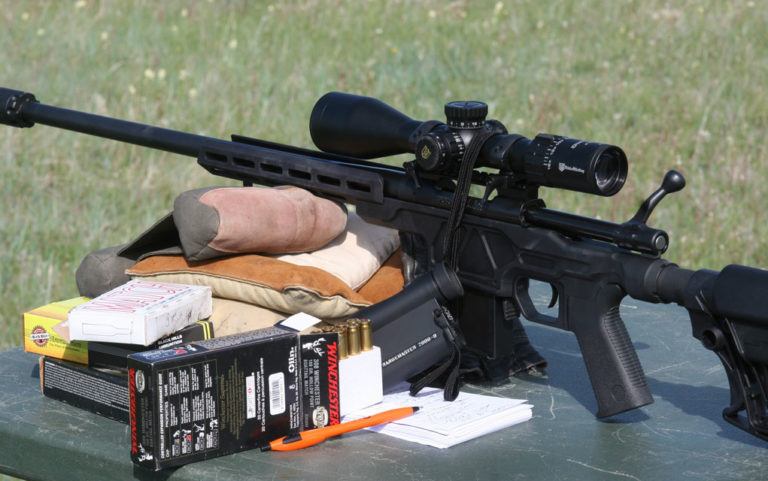
When it comes to a precision chassis rifle, the Howa HCR hits the sweet spot on accuracy and affordability.
Does the Howa HCR go the distance?
- The new Howa HCR is available in .308 Win., .223 Rem., .243 Win., and 6.5 Creedmoor.
- It boasts a 24-inch barrel with a medium-heavy contour and Howa’s 1500 action.
- Accurate-Mag builds the chassis, milled from 6061-T6 aluminum.
- It successfully and consistently engaged targets around 600 and 909 yards downrange.
- It's priced reasonably compared to other chassis rifles yet remains highly accurate.
It’s safe to say that I go back a ways with chassis rifles and Howa firearms manufacturing. I’ve hauled around my personal Weatherby Vanguard Back Country in .257 Weatherby Magnum for many years, and because the folks at Howa manufacture the Vanguard action and barrel, I feel pretty safe in saying that the Howa is a top-end barreled action, and well worthy of respect among serious shooters.
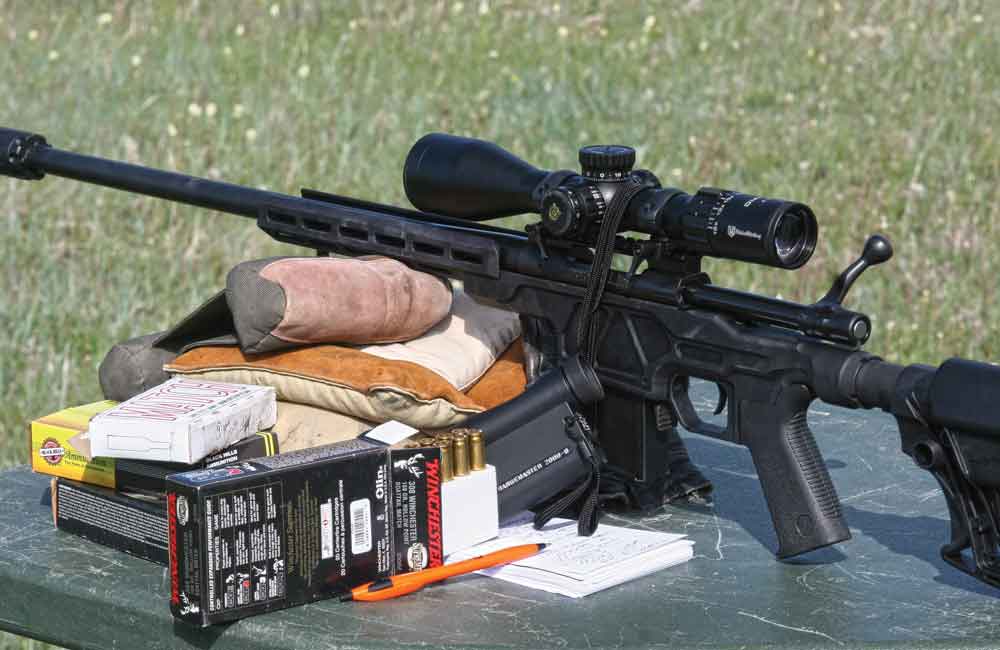
I’m also no stranger to chassis-style rifles. I’ve published three books on the subject of long-range high-performance rifles, and am in the process of writing a fourth, and in the course of researching and testing rifles for those projects, I’ve come across many different chassis rifle designs. In the past 7 years or so, the topic of chassis rifles has figured prominently in my written work. There is no doubt in my mind that this design has completely revolutionized the whole quest for rifle accuracy within the past 10 years. In fact, its promise is clearly evident based on the fact that just about every major rifle maker in the industry is now offering a chassis rifle as part of its lineup.
The Howa HCR chassis rifle is a representative example of the all-metal rifle versus the more conventionally stocked products available to shooters. Long-range, target and military shooters learned long ago that when a barreled action is married to a rifle stock system with a solid bolt-to-frame link up, the end result is no variation of drift or accuracy. The bottom line here is that the total system won’t change the impact point of bullets, as will some of the more standard wood- and plastic-stocked designs.
A Rifle of Many Faces
Howa builds a vast number of different models of the HCR rifle, so I can only state that due to space and time constraints here, the buyer needs to check out a complete catalogue to see all the available offerings. I quit counting the number of different models, which vary in terms of chambering, furniture additions, colors, as well as a multitude of add-on features, at number 110. Yes, there were more. The Howa HCR is offered in a total of 19 base combinations, and each of those retains from six to eight variants as well. While some companies offer a chassis rifle (one or two), Howa pulled the plug out of the bathtub on this deal. Just think about it, they build it as an over the counter box rifle.
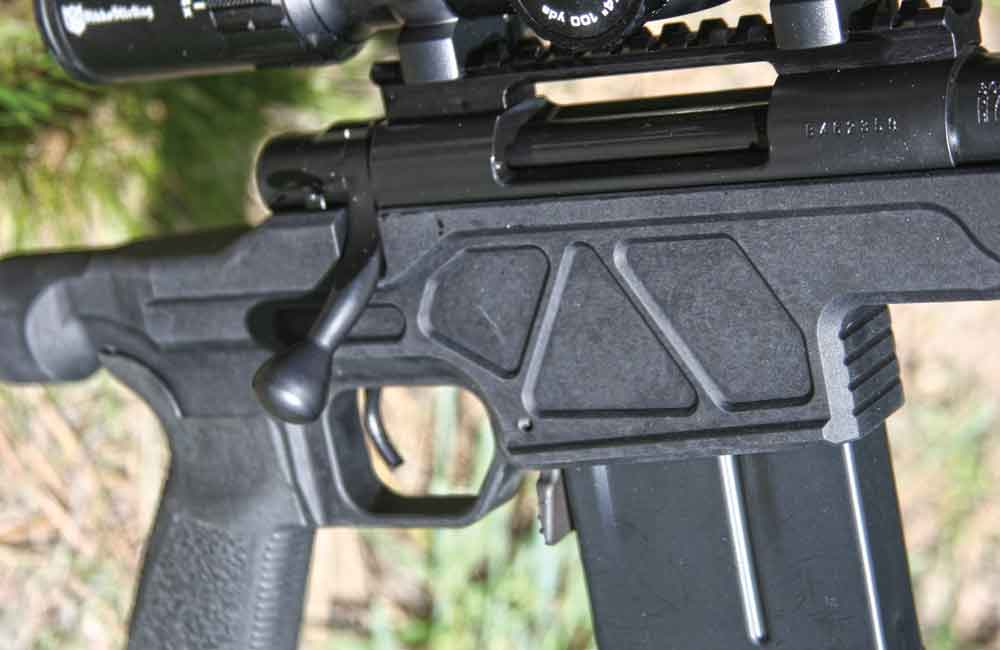
The rifle sent to me by Legacy Sports International/Howa was quite representative of this chassis rifle line. My rifle retained a medium-heavy barrel (.880 inch) that also had the threaded muzzle with steel cap installed as a suppressor-ready system. The HCR, being chambered in .308 Winchester, is also available in .223 Rem, .243 Win. and 6.5 Creedmoor. The .308 Winchester model utilized a 24-inch barrel with a 1:10 twist (right hand). When the rifle is ordered in the 6.5 Creedmoor or .308 Winchester, a longer 26-inch barrel can also be obtained as another option.
The receiver of the chassis rifle is the basic Howa Model 1500, which is CNC machined from a single steel block. As a “short action” throw, this push-feed twin-lug bolt travels 4.540 inches. Howa changes the bolt travel length based on cartridge length. Receiver controls consisted of a left-side bolt release that is simple to use and a sliding thumb safety on the right side of the receiver’s rear. The 10-round AI-style Accurate-Mag box is coated so as to aid in smooth magazine well function.
The forend and receiver base housing is built using 6061-T6 aluminum. This is not grandma’s pots and pans aluminum but rather a special blend to aid in strength retention, and it offers some ability to fight off field wear as well. This complete chassis is built by Accurate-Mag with a free-floating M-LOK mounting system.
Again, one of the outstanding qualities of a chassis rifle is that they all make use of a barrel that stands alone down the forend tube, being attached only to the receiver ring itself. The butt stock as a system is AR styled with full length of pull and comb adjustments on board. This system is the LUTH-AR MBA-3, and it provides six-position adjustment for length by way of the AR-style primary tube. The chassis stock is also adaptable in terms of add-on AR-type accessories. Whereas the rifle could be used for competitive shooting, varmint applications or informal long-range steel shooting, it has been built with the ability to become exactly what the shooter desires.
The trigger on this Howa HCR is a two-stage system with a measured break of 2 pounds, 9 ounces, based on my Timney trigger scale. The trigger is very smooth, with a clean, sharp let off. I’ll talk more on this later when I cover accuracy testing.
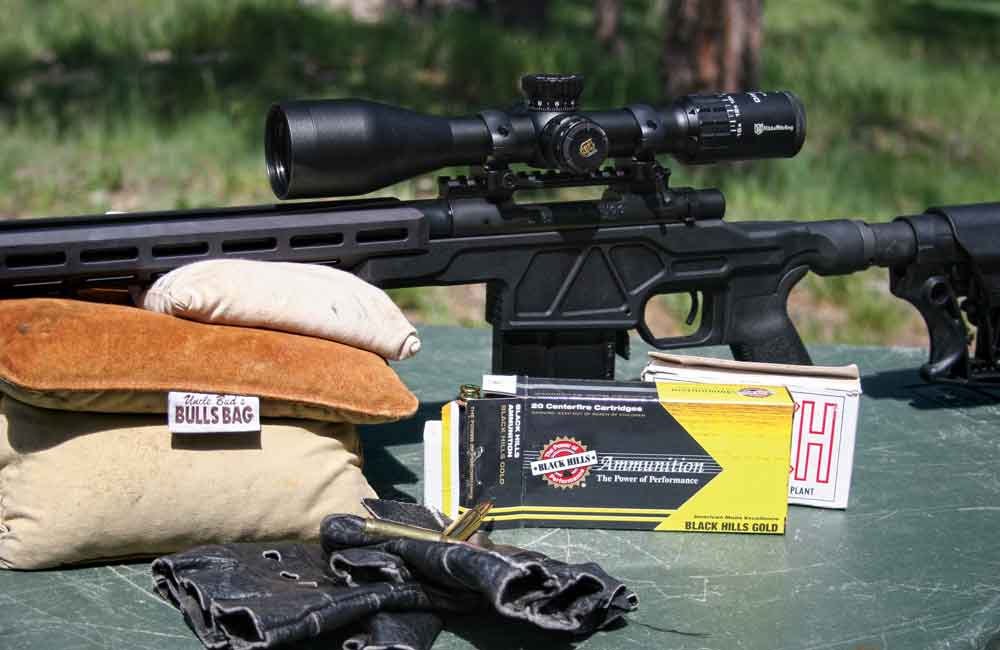
As a package rifle — and all of these systems are just that, with many options available to the shooter — my test rifle retained a set of high rings and bases that locked onto a 20 MOA angled, Weaver-style rail. The scope used on this rifle was a Nikko Stirling Diamond Long Range. This glass features a 4-16×50 optic with MOA graduations on a large volume turret setup. With 4 MOA available off the reticle directly, the second focal plane system was without question set up for direct turret elevation applications.
When under live fire testing at extended ranges, it becomes evident that this rifle was set up for long-range applications. And at its fair price of less than $1,600, it’s an affordable option to budget-conscious shooters looking to make the jump into long range. Included in this package system is a complete bottom metal system in the event the owner wants to set a standard plastic or wood stock system against the barreled action for lighter carry weight for use in hunting applications, etc. The short form here is that Howa has thought of just about everything in terms of marketing this rifle to serious long-range shooters.
DownRange
With bad weather closing fast within the week on the great western Dakota prairie country, getting out to the range and performing an accuracy test before the weather worsened was vital. I needed to establish a zero with the scope and then shoot and measure some representative groups at 100 yards. Once I established a zero at 100 yards and shot several groups, my next step would be to stretch the Howa’s legs and see how it performed at long range.
When shooting for groups at 100 yards, I found that the new Sierra (Tipped MatchKing) TMK 168-grain bullet handloads I had loaded off my old RCBS C frame at home using military match cases and Varget powder had taken top marks. The best three-shot group with this Sierra handload measured .770 inch. Later on in testing, I would use this same load for the lion’s share of the work on the long-range targets.
I continued to use the Sierra TMK projectile, but this time a 155-grain offering from Black Hills Ammunition, and it produced a best group of .862 inch at 100 yards. The final entry selected as a test round would be Winchester’s 168-grain HPBT Match load. This round again produced solid groups of .972 inch during the zero process and did well in green-bore shooting prior to going long with the now prepped and seasoned rifling.
I mounted a 12-inch Mack Brothers “Varmint” series suppressor from Dakota Silencer, Inc., to the Howa’s 24-inch barrel, ending up with a combined length of 36 inches. This would do two things for my long-range shooting. First, it would increase velocity at the muzzle regardless of the bullet or load, and secondly, it made for an almost recoil-free environment when I tried to follow my bullet impacts (splash) for target correction at long range.
In general, and this is mostly just a WAG (wild ass guess), the .308 168-grain bullet, by my estimations, would now carry as much velocity at 3,400 feet above sea level as would the .30-06 Springfield round at sea level. I do know that going from shooting at sea level to shooting at 13,000 feet in the mountains changes everything about a bullet’s performance downrange. Based on this element of performance enhancement, the Howa HCR in .308 Winchester had a good chance of showing some good stuff against targets even a half-mile or more away.
Open Range
With zeroing, bore prep and a general shakedown of the rifle completed on day one, I then turned to a second morning out on the vast South Dakota prairie. This time my focus would be on engaging selected targets at long range. I set up my portable bench rest and ranged a target out at just under 600 yards, based on readings from my Leica 2000 rangefinder.

Clicking 12.6 MOA up on the scope’s turret, based on my pre-configured DOPE, I then pushed a full MOA into a 35-percent value cross wind of 8 mph and gusting. I sent the first round, one of my 168-grain Sierra TMK handloads, downrange at a basketball-sized round boulder. At the shot, the earth erupted just over the top of my target, sending a cloud of dust into the air. With a single click correction, the next round returned a solid slap and rock chips went everywhere.
With two more confirming shots on the small boulder, and then two additional solid hits, I turned my attention toward a small dark rock against a high butte that the Leica measured at 909 yards downrange. The target measured about 25 inches in size, and the range required a 26.3 MOA click adjustment from zero. I had a wind advantage now, as my shot would carry in an almost following airflow. It took two rounds to get zeroed on the target (visual splash), but round three slapped dead on, and that shot was followed by a series of eight timed shots that produced three solid hits and two skimmers against my almost 1,000-yard small boulder target.
Shooting on the third day afield produced some very interesting target events. I wanted to test the Howa HCR on a warm target, and with that in mind, I searched out a 100 or so acre prairie dog town that stood above a large stock tank.
From a static position, I let loose some of the Black Hills 155-grain Sierra TMKs at dogs ranging from 174 to 300 yards. Dialing up or down, and taking my time by keeping my suppressor and barrel cool, the rifle flat out performed like a well-oiled machine. Over the course of an hour’s time, I had 27 kills and four missed dogs stacked up to the rifle’s credit.
Additional fun, however, came when I cranked up on the turret adjustments and then sent some Winchester 168-grain Match rounds out to 799 yards, and straight through the passenger window of an old junk Desoto. Many readers here might not even know what a Desoto is, a dead giveaway as to the car’s age, and mine as well for that matter.
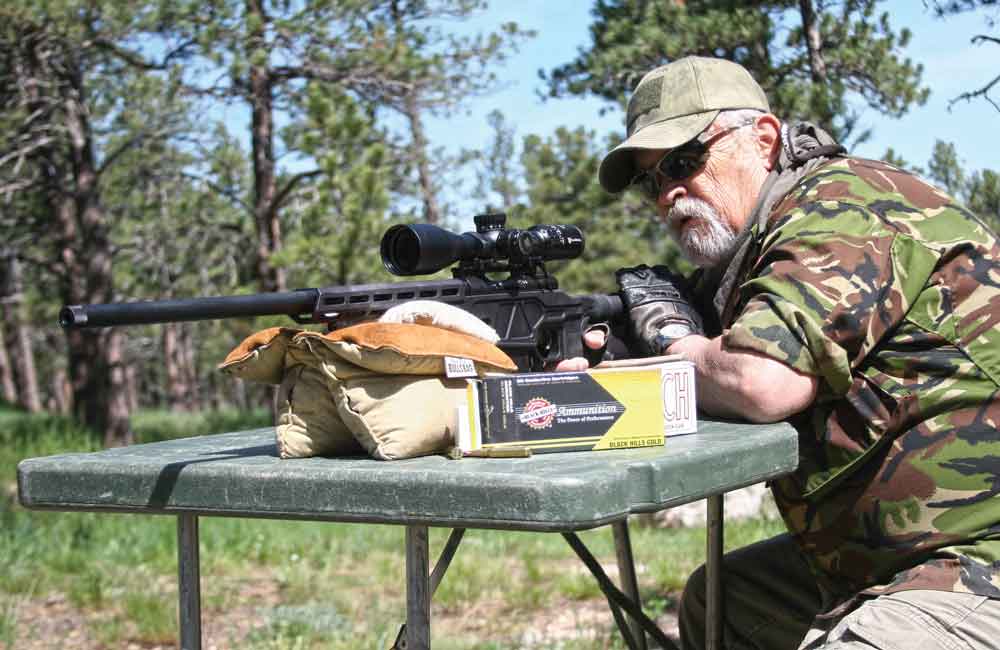
I spent the next hour shooting parts off junk pile vehicles at one half-mile away. I quickly came to the realization that the Howa HCR in any of its massive number of variants will shoot right along with any of the high-grade long-range systems on the market today. The only thing holding this rifle back from the super one-mile-plus rifles is cartridge size, bullet weight and muzzle velocity. Until the .308 cartridges used in this test went transonic, the Howa HCR did everything required of it and more.
Specifications:
Howa HCR
Type: Bolt-Action, Chassis
Caliber: .308 Win., .243 Win., .223 Rem., 6.5 Creedmoor
Action: Howa 1500
Barrel: 20 to 24 in.
Overall Length: 39 to 47.25 in.
Weight: 9 to 10.5 lbs.
Finish: Black, Multicam/FDE, many options
MSRP: $1,239 to $1,725
Editor's Note: This article is from the August 2017 issue of Gun Digest the Magazine.
More Precision Shooting

Next Step: Get your FREE Printable Target Pack
Enhance your shooting precision with our 62 MOA Targets, perfect for rifles and handguns. Crafted in collaboration with Storm Tactical for accuracy and versatility.
Subscribe to the Gun Digest email newsletter and get your downloadable target pack sent straight to your inbox. Stay updated with the latest firearms info in the industry.

![Best Concealed Carry Guns In 2025 [Field Tested] Wilson Combat EDC X9S 1](https://gundigest.com/wp-content/uploads/Wilson-Combat-EDC-X9S-1-324x160.jpg)


![Best 9mm Carbine: Affordable PCCs [Tested] Ruger Carbine Shooting](https://gundigest.com/wp-content/uploads/Ruger-Carbine-Shooting-100x70.jpg)
![Best AR-15: Top Options Available Today [Field Tested] Harrington and Richardson PSA XM177E2 feature](https://gundigest.com/wp-content/uploads/Harrington-and-Richardson-PSA-XM177E2-feature-100x70.jpg)
